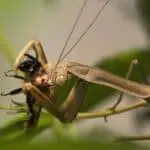As you keep mantis, at a certain stage you may want to breed them. Not only is it interesting to breed mantis, it also saves you money in the long run. Here’s a beginner’s guide on how to breed mantis.
Place well-fed male and female mantis in the same enclosure with some twigs and let them mate. Remove the male after they mate and give the female adequate water. Remove her after she has laid egg cases. Feed the hatched nymphs with springtails, aphids or fruit flies. Separate them as they molt.
Breeding mantises is not difficult but it does require some effort due to the diet and size of the mantis. Continue reading if you want to know more details on how to breed mantis.
Male vs Female Praying Mantis
Obviously you need a male and a female mantis to breed them. There are a few clues for you to distinguish between male and female mantises.
The most accurate way to identify the sex of a mantis is by counting the abdominal segment. Look at the abdominal segments of the mantises from their underside. A male mantis has 8 abdominal segments while a female mantis has 6. This is more conspicuous in older nymphs (5th instar onward) and adults compared to younger nymphs.
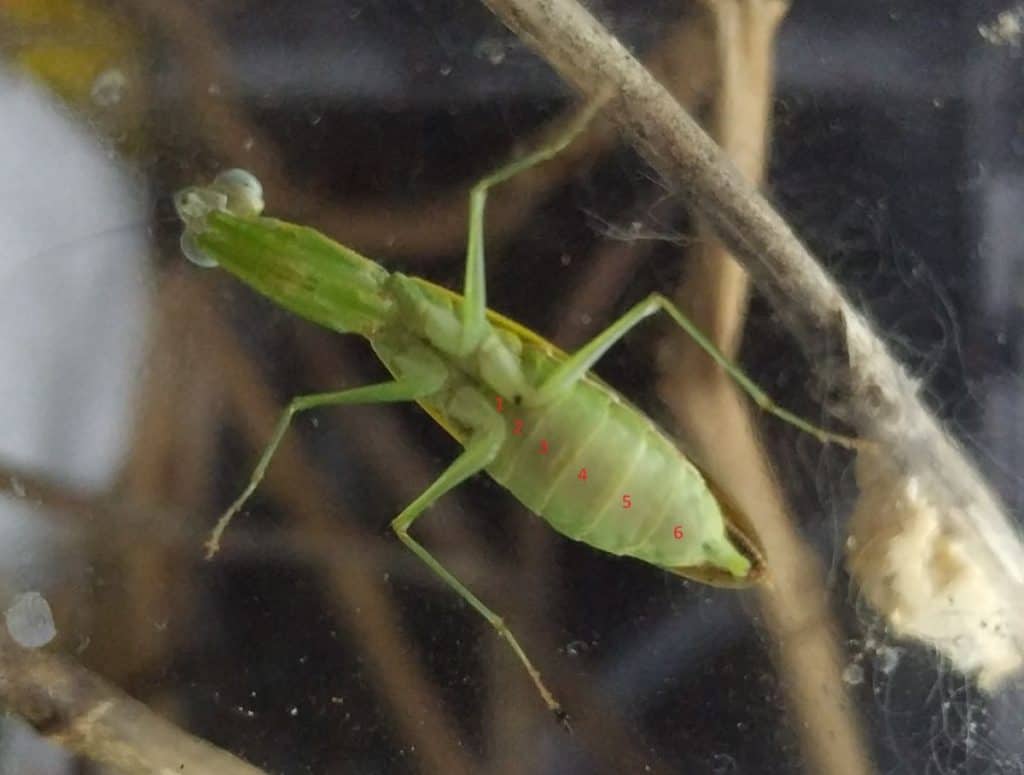
To accurately count the segments, you can let the mantis walk on your hand or a twig. Then, snap a photo from below and count the segment from the photo.
Generally, a female mantis is larger and bulkier than their male counterpart. However, do note that the sizes of mantises can vary by instar. If you are using size as an indicator, make sure you are comparing the mantises of the same instar. You cannot accurately determine the sex of the mantis if you have only 1 mantis with you.
Some mantis species have distinct morphological differences on the male vs female. For instance, the female orchid mantis nymph has a horn-like structure between her eyes while the male lacks one. On top of that, the female nymph has a green marking on her back while the male orchid mantis has a brownish marking. When orchid mantis reach adulthood, the male looks very different from the female mantis.
Another clue that you can look at is the length of the wings. Male mantises often have longer wings because they need to actively search for mating opportunity. Usually, their wings go over their abdomen. In contrast, female mantises have shorter wings, reaching the tip of their abdomen or shorter than that. This method can sex only adult mantises since the nymphs don’t have wings.
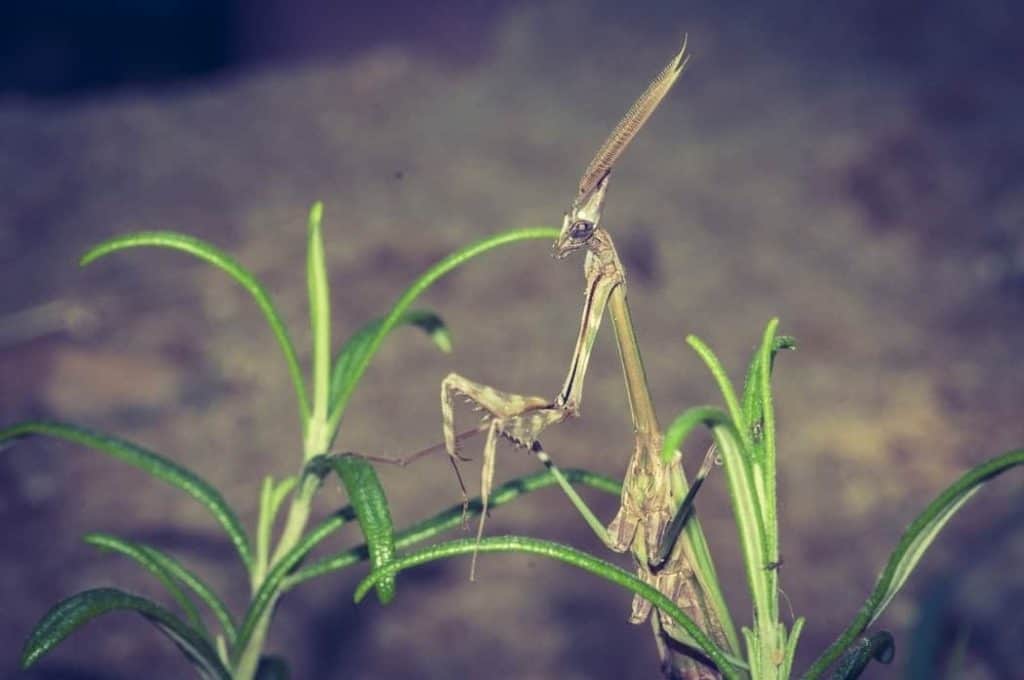
Yet another clue is to check their antennae. Male mantises generally have longer and thicker antennae while the female’s antennae are shorter and thinner. In certain species such as the Empusa sp., the male mantises have feathery antennae.
At least 1 species (there could be more), the Brunner’s mantis, has only female mantises. They lay eggs without mating (since there is no male mantis for them to mate with).
Pairing the Mantises
You can start pairing your mantises 2-3 weeks after their last molt into adults. Mantises are not sexually active until then. In case you are not aware, nymphs do not mate because their sexual organs are not developed yet.
Prepare a temporary enclosure. It should be transparent if possible, and can be anything such as a plastic cookie jar or a plastic cup. The dimensions of this enclosure should be 2-3 times the length of the mantis so that they can move freely.
Make a few tiny holes in the container for ventilation and lay 1 paper towel at the bottom of the container. Then, add some twigs in the container.
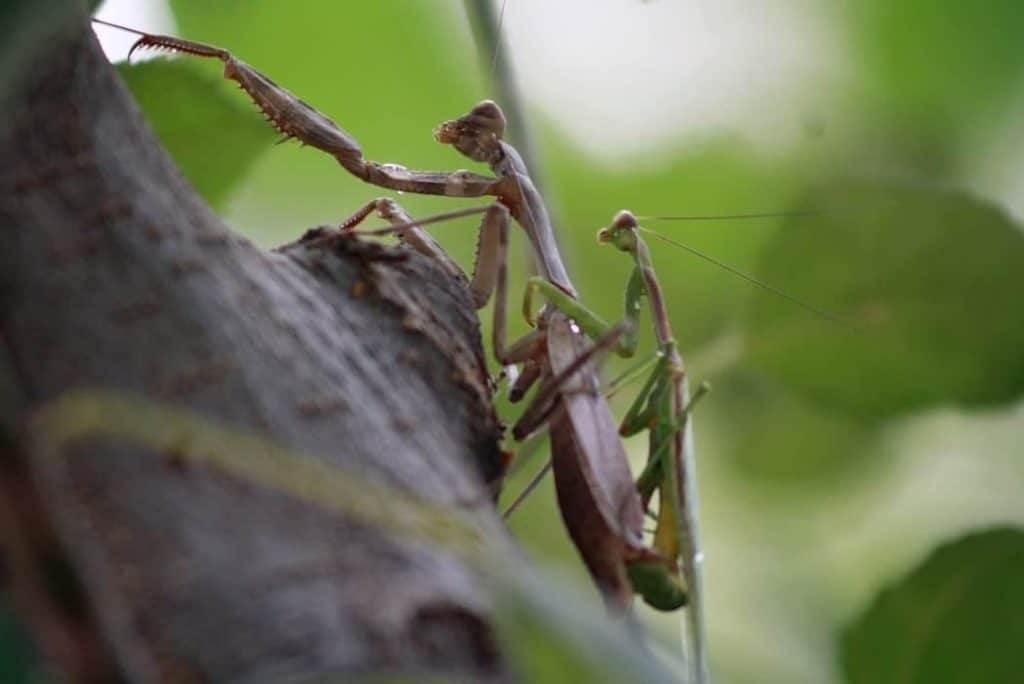
Put both mantises into the container and let them mate. To reduce the chance of cannibalism, feed your female mantis before you attempt this.
If both mantises are ready, mating can happen very fast. The male mantis will mount on the female for copulation and come down when he is done. This process can take 1-6 hours. After mating, remove and place the male mantis back to his original housing.
If the mantises refuse to mate, separate them and try again after 2 more days. A slightly warmer temperature and bigger enclosure can encourage mating.
Note that mantises can mate repeatedly. For the male mantis, the quality of mating drops with each successive copulation. Let him rest for a few days before the second mating. Conversely, repeated mating with different male mantises can improve the egg fertility of the female mantis.
Occasionally, the female mantis may decapitate and consume the male mantis while mating. Not sure what triggers this behavior, but it may or may not happen. Feeding both the male and female mantis before mating might reduce the likelihood of this happening.
Certain mantis species such as the Springbok mantis, can lay viable eggs without mating. But it is good to mate them so that you have a chance of getting “fitter” offspring.
Egg Laying
The gravid mantis likely refuses to eat anything. Just make sure they have access to water by misting or sprinkling water with your hand.
Within 3 weeks after mating, the female mantis will start to lay eggs. Most likely the mantis will lay eggs on the twigs or branches, if it is available in the enclosure. Certain species prefer to lay eggs in the soil, leaf litters or underneath rocks.
The eggs are enclosed in an ootheca, or egg case. The mantis may lay 2-6 ootheca, each containing 50-300 eggs. The eggs laid earlier usually have higher hatchability than the subsequent eggs.
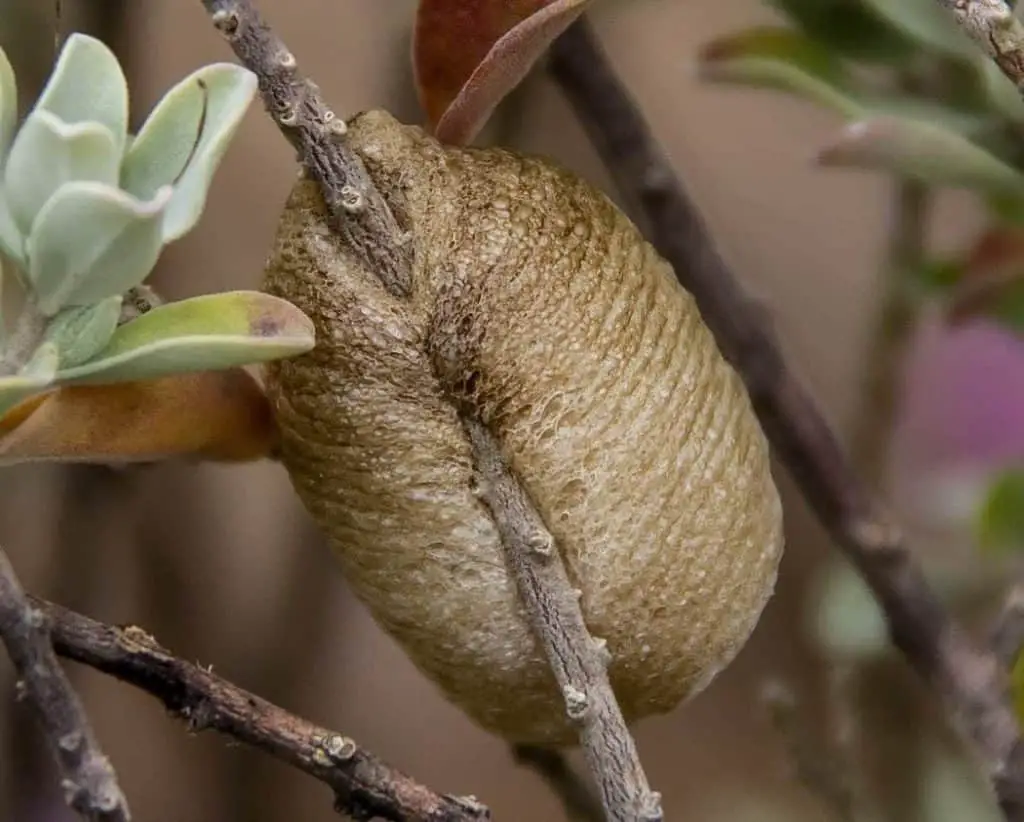
Move the mantis back to her original housing after she has done laying eggs. In temperate regions, the female mantis will die shortly after laying eggs since she lays eggs when it is close to frost. You can prolong her lifespan for a few weeks by maintaining a warmer temperature.
Caring for Mantis Eggs
The egg cases are wet when laid. It will slowly dry up in 3-4 days. After it dries up, you can put a wet paper towel in the same container to give some moisture.
The mantis from temperate regions overwinter in the form of eggs and should hatch in spring. Keep the eggs at a lower temperature until spring. Meanwhile, the tropical species will hatch in 1-3 months if the temperature is conducive.
Note that not all eggs will hatch.
Caring for Baby Mantis
Baby mantises are tiny and fragile when hatched. They hang themselves on the ootheca until their skins are hardened.
Feed the baby mantis with springtails, pinhead crickets, or flightless Drosophila fruit flies, depending on the size of the mantis. I have a guide that shows you how to get and breed springtails which you can refer to. At a younger age, the baby mantises are not as aggressive and may be starved to death without adequate food.
Provide enough moisture by keeping a wet paper towel in the enclosure. Do not mist when your nymphs are still small because they may drown in the water droplet. Both humidity and temperature should be maintained according to the species-specific requirements.
After 1-2 molts, move the nymphs into separate containers. They should be housed individually to prevent cannibalization. Increase the size of housing and feeder insects as the nymphs grow.
Last Words
I hope you find this guide helpful. To learn more about keeping mantis, refer to our guide here.
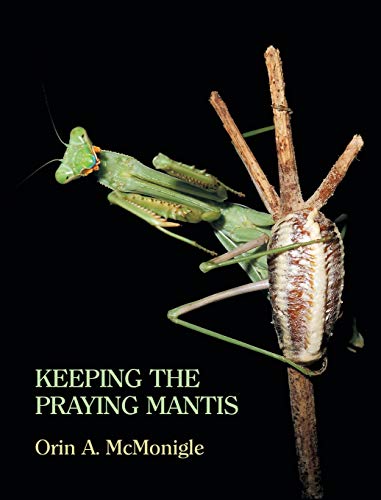
Keeping the Praying Mantis
This is great book by Orin McMonigle on mantis keeping. Written in an easy to understand and concise manner, this is the ultimate guide that any serious mantis-keepers need to read!
Additional Information
My mantises refused to mate. What should I do?
Mating is a natural action. When your mantises refused to mate, separate them. Try again after a few more days. Make sure the mantis are well-fed. If it is cold, keep the temperature warmer. Placing your mantises in a larger container also can facilitate mating.
Why do female mantises eat male mantises when mating?
Mantises exhibit sexual cannibalism, where the female may eat the male before, during, or after mating. There are a few theories to explain this behavior:
- The female mantis is hungry
- The female mantis is weak and need more nutrients
- The male mantis is deemed not worthy (to mate)
- The male mantis is weak and hence perceived as an easy prey
How do I prevent the female mantis from eating the male when mating?
There isn’t anything much you do to stop the female from attacking the male mantis before or during mating. But you can prevent the attack after mating by removing the male mantis immediately after he is done.
Feed your male and female mantis prior to mating. That may or may not reduce the chance of sexual cannibalism. Adding some feeder insects in the mating room may also help to keep the female distracted and hence, sparing the male mantis.
My mantis eggs do not hatch. What should I do?
Make sure the temperature and humidity are maintained according to the species-specific needs. Some species take longer to hatch than others. To improve the eggs’ hatchability, you can let the same female mate with multiple male mantises.
My mantis died after mating before she lays eggs. Will the eggs hatch if I remove them from her abdomen?
The eggs from a dead mantis won’t hatch. The female mantis stores the sperms she received in a sperm sac while the unfertilized eggs are stored in the ovaries. Those eggs are fertilized only at the moment they are passed out.


